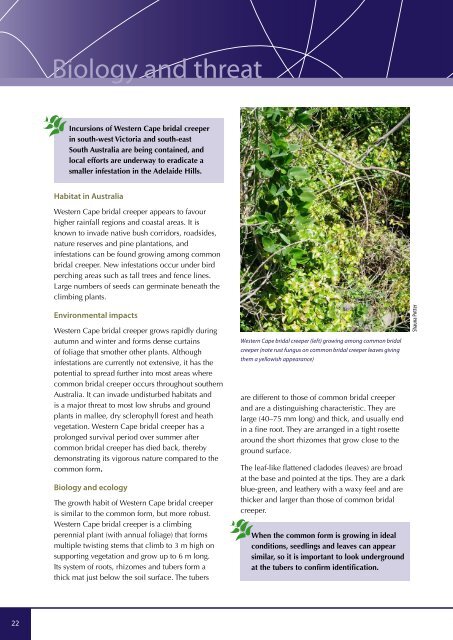Asparagus weeds - Weeds Australia
Asparagus weeds - Weeds Australia
Asparagus weeds - Weeds Australia
- No tags were found...
Create successful ePaper yourself
Turn your PDF publications into a flip-book with our unique Google optimized e-Paper software.
Biology and threatIncursions of Western Cape bridal creeperin south-west Victoria and south-eastSouth <strong>Australia</strong> are being contained, andlocal efforts are underway to eradicate asmaller infestation in the Adelaide Hills.Habitat in <strong>Australia</strong>Western Cape bridal creeper appears to favourhigher rainfall regions and coastal areas. It isknown to invade native bush corridors, roadsides,nature reserves and pine plantations, andinfestations can be found growing among commonbridal creeper. New infestations occur under birdperching areas such as tall trees and fence lines.Large numbers of seeds can germinate beneath theclimbing plants.Environmental impactsWestern Cape bridal creeper grows rapidly duringautumn and winter and forms dense curtainsof foliage that smother other plants. Althoughinfestations are currently not extensive, it has thepotential to spread further into most areas wherecommon bridal creeper occurs throughout southern<strong>Australia</strong>. It can invade undisturbed habitats andis a major threat to most low shrubs and groundplants in mallee, dry sclerophyll forest and heathvegetation. Western Cape bridal creeper has aprolonged survival period over summer aftercommon bridal creeper has died back, therebydemonstrating its vigorous nature compared to thecommon form.Biology and ecologyThe growth habit of Western Cape bridal creeperis similar to the common form, but more robust.Western Cape bridal creeper is a climbingperennial plant (with annual foliage) that formsmultiple twisting stems that climb to 3 m high onsupporting vegetation and grow up to 6 m long.Its system of roots, rhizomes and tubers form athick mat just below the soil surface. The tubersWestern Cape bridal creeper (left) growing among common bridalcreeper (note rust fungus on common bridal creeper leaves givingthem a yellowish appearance)are different to those of common bridal creeperand are a distinguishing characteristic. They arelarge (40–75 mm long) and thick, and usually endin a fine root. They are arranged in a tight rosettearound the short rhizomes that grow close to theground surface.The leaf-like flattened cladodes (leaves) are broadat the base and pointed at the tips. They are a darkblue-green, and leathery with a waxy feel and arethicker and larger than those of common bridalcreeper.When the common form is growing in idealconditions, seedlings and leaves can appearsimilar, so it is important to look undergroundat the tubers to confirm identification.Shauna Potter22
















